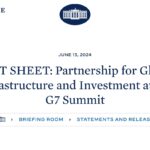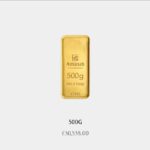In the realm of safeguarding one’s investments from a potential default by the United States government, the query arises: By what means can an astute investor ensure their protection? In times past, such a question would have been regarded as preposterous. However, in the present landscape of American politics, the extraordinary has transcended into the realm of the commonplace.
And while US president Joe Biden and House Speaker Kevin McCarthy have both indicated they want to cut a deal to raise America’s $31tn debt ceiling — and thus avoid a putative default — significant sticking points remain. So Wall Street analysts are now furtively weighing the protection options as they grapple with this new tail risk. Some, like those at JPMorgan, argue that “diversification is the best defence,” and urge investors to “consider currencies and precious metals like the Japanese yen, the Swiss franc, and gold [and] high quality international equities.” That sounds sensible.
As the intentions of US President Joe Biden and House Speaker Kevin McCarthy align in their desire to reach an agreement to raise America’s staggering $31 trillion debt ceiling and consequently evade a potential default, there are still substantial obstacles impeding progress.
Accordingly, Wall Street analysts are presently discreetly assessing the available safeguarding options as they grapple with this newly emerged risk factor.
Among them, JPMorgan experts assert that “diversification stands as the most effective form of defence” and strongly recommend that investors “deliberate on currencies and precious metals such as the Japanese yen, the Swiss franc, and gold, alongside high-quality international equities.” This prudent suggestion carries considerable weight.
Nevertheless, there are those who maintain a more targeted perspective on the matter. RBC Capital Markets, in the preceding week, put forth the notion that “gold appears to be one of the few viable contenders capable of shouldering the weight of market shifts resulting from apprehensions surrounding a default.”
Echoing this sentiment, a recent survey conducted by Bloomberg affirms gold’s position as the foremost choice for both professional and retail investors in terms of safety. This preference is overwhelming, with 52 percent and 46 percent of respondents, respectively, selecting gold as their preferred option.
Following gold, we find Treasuries as the next choice, albeit selected by a smaller proportion of respondents—14 percent among professionals and 15 percent among retail investors. This may initially seem counterintuitive, but the rationale becomes clear when one considers that a default would likely trigger a recession in the United States. In third place, we find Bitcoin, trailing behind significantly, followed by the dollar, yen, and Swiss franc.
Ideally, one would hope that all of this remains purely theoretical. However, even in the event of successfully averting a default, it is essential to take note of the implications. Firstly, it highlights the extent to which leaders within the Eurozone have been unable to convince investors of their currency’s viability as a genuine alternative to the dollar.
Secondly, this trend serves as a significant blow to cryptocurrency enthusiasts. After all, bitcoin was conceived as an alternative to the existing dollar-dominated financial system. If the majority of mainstream investors turn away from it when faced with a crisis in the established order, it raises concerns about the future prospects of bitcoin.
However, the third and most intriguing observation revolves around gold. Merely a couple of decades ago, investing in this asset appeared oddly outdated, given its lack of yield. Yet, this month, the price of gold has soared, trading near an all-time high (without adjusting for inflation) of $2,069.40 per troy ounce. It has experienced a remarkable rally of 20 percent since November and has doubled in value since 2016.
Of greater significance, recent developments in the trading pattern of gold have revealed subtle yet remarkable shifts. Traditionally, the price of gold exhibited an inverse correlation with long-term Treasury yields linked to inflation. This relationship was based on their shared ability to serve as a hedge against inflation. However, a noteworthy change has taken place since early 2022. Despite the rise in real yields, the price of gold has also surged. This deviation from the norm can be attributed, in large part, to the actions of various central banks seeking to diversify their reserves away from the dollar in response to Western sanctions imposed on Russia following its invasion of Ukraine. Analysts at Bridgewater, a prominent US hedge fund, point to this as a major contributing factor.
Indeed, data published by the World Gold Council this month highlights that central bank purchases of gold reached a record high in the first quarter of this year, following the previous year’s record annual highs. Louise Street of the Council predicts that central bank buying will continue to be robust throughout 2023, serving as a fundamental pillar of demand. This serves as a striking reminder of the frustration felt by countries such as China and Russia towards the dominance of the dollar-based global order, even in the absence of a viable alternative at present.
Nonetheless, Bridgewater puts forward another factor that has contributed to the ongoing rally in gold. They suggest that the combination of 15 years of quantitative easing and recent bouts of high inflation has led both central banks and individual investors to seek refuge in gold as a reliable store of value.
Bridgewater highlights a noteworthy shift in perception, stating, “There has been a transition from investors primarily viewing gold as an alternative to other dollar-denominated savings to increasingly considering gold as an alternative to the dollar itself.” They also point out that the traditional correlation between the dollar and the price of gold has recently shown signs of breaking down.
Given these circumstances, it is unsurprising that investors, whether they be central banks or perplexed consumers, are embracing gold as an integral part of their hedging strategies against the possibility of a US default.
Perhaps this pattern will change in the event of a debt deal. Indeed, McCarthy’s comments have already caused a slight dip in the gold price. It is worth noting that during the previous debt ceiling crisis in 2011, the price of gold also initially rose but subsequently declined following the resolution of the crisis through a deal.However, I harbour doubts that history will unfold as neatly this time around, particularly considering the prevailing concerns surrounding inflation, the weaponisation of the US dollar, and the persisting political dysfunction in America, which will not be resolved solely through a debt ceiling agreement.
The key point is that gold is now a good barometer not just of global instability, but of US dysfunction too!














